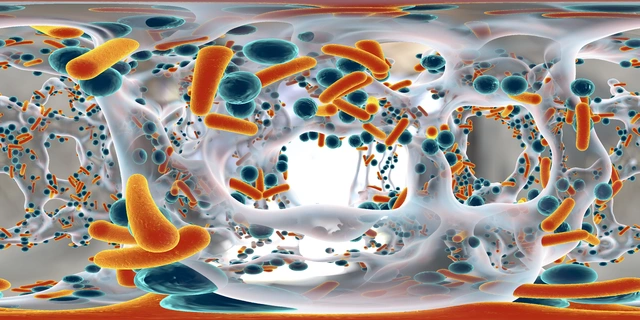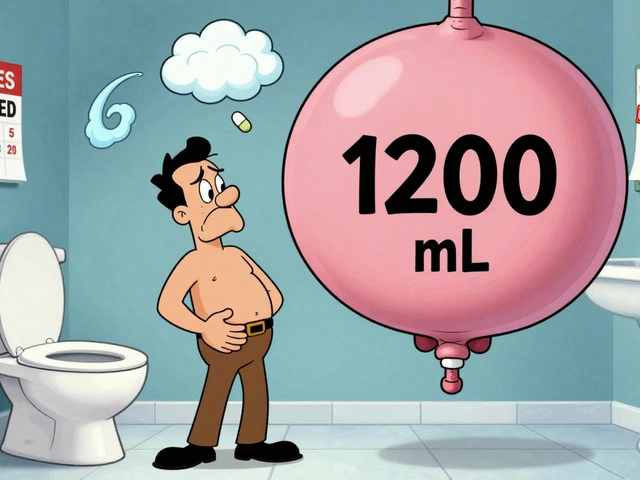Clavulanic acid may sound like a mouthful, but it’s a tiny hero rewriting the story of modern antibiotics. Ever found yourself flattened by a sinus infection, only to discover that the usual pill doesn't even make a dent? You’re not alone. Every year, millions of people around the world run into this invisible wall called antibiotic resistance. Doctors, pharmacists, and even parents swap stories about once-deadly bugs now brushing off our best medicines like they’re nothing more than vitamin C. But behind the scenes, scientists have been brewing up a clever sidekick — not a new antibiotic, but a boost button for the ones we already have. That’s where clavulanic acid comes in, quietly transforming the way we treat infections that should have been simple but just won’t budge.
What Exactly Is Clavulanic Acid?
Picture this: It’s the 1970s in the UK. Researchers at Beecham Pharmaceuticals are poking through Petri dishes looking for something that could help their aging penicillins outsmart bacteria. They stumble on a soil-dwelling Streptomyces clavuligerus, a modest bacterium hiding a big secret — it produces a compound able to block enzymes that destroy penicillin. That compound, formally called clavulanic acid but sometimes nicknamed the "magic wrench," was different from regular antibiotics. It didn’t kill bacteria on its own. Instead, it acted like the ultimate wingman, helping antibiotics like amoxicillin stay in the fight.
Clavulanic acid falls into a class called "beta-lactamase inhibitors." Here’s why that matters. Many bacteria have learned a trick: they make beta-lactamase enzymes, which chop up antibiotics before they do any damage. Think of beta-lactamase as a pair of scissors and the antibiotic as a ribbon. Whenever a drug like amoxicillin tries to tie things up, the scissors snip the ribbon apart. Enter clavulanic acid. It jams up the scissors, keeping them from working, so the ribbon stays intact and can do its job. On its own, clavulanic acid is just a blocker. But in combo with the right antibiotics, it completely turns the tables. Even stubborn bugs like some strains of E. coli or Staphylococcus, which would munch through regular penicillin, start to fold.
Here’s a tip that not everyone knows: clavulanic acid isn’t just randomly slapped onto any old antibiotic. It pairs best with drugs in the penicillin family — most famously with amoxicillin (that’s your Amoxiclav or Augmentin prescription). Together, they create a tag team stronger than the sum of its parts. If you’ve ever wondered why that combo is prescribed when a basic antibiotic might do, now you know — clavulanic acid is doing the heavy lifting against bacteria that would otherwise win.
How Clavulanic Acid Works Its Magic in the Body
It’s one thing to block an enzyme in the lab, but how does this actually pan out in your body? Take a common scenario: a chest infection in someone who’s already had a few rounds of antibiotics. The problem? Some bacteria are already wearing body armor in the form of beta-lactamase. Amoxicillin — a cousin of old-school penicillin — works by attacking the building blocks of their cell walls, causing the bacteria to burst. But if beta-lactamase is present, it clips the antibiotics before they even start.
Clavulanic acid steps in and, through a chemical handshake called "suicide inhibition," binds to the enzyme. It’s called this because clavulanic acid essentially sacrifices itself, locking up the enzyme permanently. This leaves the real antibiotic — say, amoxicillin — free to attack the bacteria head-on. It’s a bit like a secret agent taking the bullet so the hero can save the day.
The real-world results are huge. In multiple clinical studies, treatment success rates for common infections nearly doubled when amoxicillin was paired with clavulanic acid compared to amoxicillin alone against beta-lactamase producing bacteria. This combination has become the gold standard for tricky infections in the ear, sinus, lungs, urinary tract — basically, anywhere bacteria like to play dirty.
Curious about how quickly it works? Here’s some insight. The absorption of both amoxicillin and clavulanic acid in the stomach is super fast — peak levels appear in the blood in just 1 to 2 hours, which is why doctors often recommend taking these combos at the start of a meal (it reduces the risk of gut irritation). And while the amoxicillin does the heavy lifting, clavulanic acid usually sticks around just long enough to get the job done; the liver breaks it down within a few hours, reducing long-term impact on your system.
If you’re visual, check out this data comparing treatment outcomes:
| Treatment | Cure Rate (Strep Throat) | Cure Rate (UTI) | Side Effect Risk |
|---|---|---|---|
| Amoxicillin alone | 70% | 58% | Low |
| Amoxicillin-Clavulanic Acid | 93% | 91% | Moderate (GI upset) |
| Ciprofloxacin (not paired) | 87% | 89% | Moderate |
Simple takeaway: By jamming those bacterial scissors, this combo drives up cure rates in resistant infections, but it’s not without a bump in GI side effects, which is why it’s not used for every cough or sniffle. Practical tip? Take with food, drink plenty of water, and call your doctor if you get persistent diarrhea or a skin rash.

Why Clavulanic Acid Matters in the War Against Resistance
Let’s talk numbers. The World Health Organization estimates that about 1.27 million deaths every year are linked to antibiotic-resistant infections. Staggering, right? Australia isn’t immune either — recent government reports peg antimicrobial resistance as a rising threat, with common illnesses like urinary tract infections becoming harder to treat with each passing year. What causes it? It’s all about survival of the fittest. When bacteria bump into antibiotics, most die, but a slick few mutate and survive. The more we throw at them — especially for minor colds or used incorrectly — the stronger they get.
This is where beta-lactamase inhibitors like clavulanic acid really pull their weight. By resetting the power balance, these combos restore the usefulness of penicillin-type antibiotics doctors might have written off. It means less reliance on broad-spectrum drugs like ciprofloxacin, which are more likely to disrupt your gut bacteria or create even scarier superbugs. It’s a win not just for individual patients, but for society at large, stretching out the lifespan of antibiotics humanity depends on.
Here’s something not everyone realizes: resistance isn’t evenly spread. In hospitals where infection control is tight, resistance rates are lower. In places where antibiotics flow like tap water, it’s much higher. So the smart use of clavulanic acid — only when there’s clear evidence of resistant bugs — is key to making it last. According to a 2023 review by the Australian Commission on Safety and Quality in Health Care, judicious use of combo drugs helped cut resistant E. coli rates in half in some cities over three years. Science isn’t just theory — it can turn trends around, but only if people use these tools wisely.
Want a quick cheat sheet for keeping resistance at bay in daily life? Here you go:
- Don’t pressure your doc for antibiotics for simple colds. They only work on bacteria, not viruses.
- If prescribed a combo antibiotic like amoxicillin-clavulanic acid, take the full course even if you feel better halfway.
- Store medicine as directed. Heat or humidity can break down clavulanic acid faster than you’d think.
- Be honest about allergies. Rash or swelling after amoxicillin-clavulanic acid? Your doctor needs to know immediately.
Tips for Getting the Most Out of Clavulanic Acid Combinations
Doctors prescribe amoxicillin-clavulanic acid for everything from dental abscesses to animal bites. But small changes in how you take it can make a big difference in how well it works or how rough it is on your stomach. The biggest complaint? Upset stomach or diarrhea. That’s because clavulanic acid — though broken down quickly in the liver — can irritate the gut lining or mess with the balance of helpful bacteria there.
If you’ve got a prescription in hand, here’s what helps:
- Take it with food. Studies show that both amoxicillin and clavulanic acid get absorbed just as well with a meal as on an empty stomach, and you’ll dodge half the chance of GI problems.
- Spread out your doses evenly, usually every 8–12 hours, to keep blood levels steady. Set an alarm if you’re forgetful.
- If you’re on birth control, know that gut upset with antibiotics has a tiny risk of affecting absorption. Backup birth control like condoms can’t hurt for the week.
- Report persistent diarrhea, especially if there’s blood or fever, as it could signal more serious side effects like C. diff infection.
- Avoid mixing with alcohol for at least 48 hours after your last dose. This isn’t so much a chemistry thing — both can irritate your digestive tract and confuse symptoms.
If you’re giving amoxicillin-clavulanic acid to your kids, liquids often taste a bit tangy or bitter — storing in the fridge can help the flavor. And definitely finish the bottle; stopping early is what teaches bacteria how to morph and resist next time.
Wondering if you can take probiotics alongside these antibiotics? There’s some data showing that probiotics with strains like Lactobacillus can cut down on side effects like diarrhea. But don’t take them within two hours of your antibiotic dose, or the medicine might just waste your good bacteria, too.

The Future of Clavulanic Acid and Where We Go Next
Here’s a wild fact — the combo of amoxicillin and clavulanic acid is on the World Health Organization’s List of Essential Medicines. That’s the global VIP list for drugs no country wants to be without. But scientists don’t intend to rest on that formula forever. Bacteria, given enough time and pressure, always seem to find loopholes. A few strains, especially certain nasty hospital bugs, are now making "extended spectrum" beta-lactamases that can even dodge clavulanic acid’s block.
This has kicked off a race in laboratories from Sydney to Stockholm to develop next-gen beta-lactamase inhibitors. The names — tazobactam, avibactam — might not roll off the tongue, but you’ll be hearing more about them in coming years. Each is designed to handle a broader or trickier set of resistance enzymes. But for everyday stubborn infections, clavulanic acid remains the go-to, buying scientists precious years to, hopefully, outpace bacterial ingenuity.
The role of patient awareness can’t be overstated. Studies from Perth’s Fiona Stanley Hospital found that patients who understood what their medicine did and why it needed to be taken on schedule were 27% less likely to develop a repeat resistant infection. Knowledge beats guessing. So, if you’re given amoxicillin-clavulanic acid, don’t just take it and hope — ask your doctor or pharmacist: Is this the right combo for my bug? Any risks with my current meds? Anything I should be doing differently next time?
It’s easy to think of antibiotics as magic bullets and clavulanic acid as the clever tweak. But this is a constant tug-of-war. The next big leap might come from entirely new drug classes, probiotics engineered to eat up bad bugs, or even viruses that hunt bacteria (yep, phage therapy is having a comeback moment). Until then, clavulanic acid is doing the heavy lifting, quietly saving limbs and lives in doctor’s offices and hospitals every day.
So, next time you’re faced with the dreaded question, “Why isn’t regular penicillin enough?” or “Why do we use combo drugs?” — you’ve got the inside scoop. A little molecule found in the dirt beneath a British field is keeping ancient medicine relevant. Sometimes, the best game changers are the ones you never see coming.

 The science behind cefixime: how it works to fight bacterial infections
The science behind cefixime: how it works to fight bacterial infections
 Calcipotriol for Psoriasis in Skin of Color: Benefits, Risks & Usage
Calcipotriol for Psoriasis in Skin of Color: Benefits, Risks & Usage
 SSRIs and Opioids: Understanding Serotonin Syndrome Risk and How to Prevent It
SSRIs and Opioids: Understanding Serotonin Syndrome Risk and How to Prevent It
 Anticholinergics and Urinary Retention: How Prostate Problems Make the Risk Worse
Anticholinergics and Urinary Retention: How Prostate Problems Make the Risk Worse
 Understanding Drug Labels: A Complete Medication Label Breakdown
Understanding Drug Labels: A Complete Medication Label Breakdown
Joshua Logronio
July 18, 2025 AT 04:28So, I gotta ask, does this mean Clavulanic acid is like the secret weapon they don’t want us to know about? I swear, sometimes it feels like Big Pharma is keeping these miracle combos on lockdown while pushing overpriced meds. This article makes it sound super promising, like a game changer against resistant bacteria. But how come we don’t hear more about it on the news or from our doctors directly?
And what about those bacteria mutating faster than we can keep up? It’s like a never-ending arms race, but I get the feeling the info is being controlled to keep us in the dark. Still, I’d love to see more real-world reports on how effective this combo is in practice. Anyone here had experience with it or know if it actually works without crazy side effects?
Nicholas Blackburn
July 18, 2025 AT 05:28Honestly, I can't stand how people toss around medical terms like they're candy - makes me wanna scream. Clavulanic acid isn't some magical cure-all; it's just a beta-lactamase inhibitor that helps antibiotics work better. Get your facts straight before hyping stuff up.
Also, some people spouting nonsense about 'secret weapons' make me question the intelligence of this community. It's basic science, not some conspiracy. If you don’t understand it, maybe just listen instead of rambling about Big Pharma hiding cures. Grow up.
And yeah, antibiotics resistance is a serious issue, but misinformation only makes it worse. Read some legit literature before acting all paranoid.
Dave Barnes
July 18, 2025 AT 07:22It’s fascinating when you think about how such a small molecule can shift the fate of entire treatment paradigms. Clavulanic acid essentially says, 'Hey bacteria, your usual tricks won’t work here,' and that’s a monumental shift. It’s kind of poetic in a way – a molecular underdog beating back resistance with subtle cunning.
But isn’t that a reflection of the constant flux in nature? Just when we get comfortable with a treatment, bacteria evolve, and we have to adapt too. Clavulanic acid is like a philosophical reminder that we must stay flexible and innovative in the face of change.
What do you think about this interplay between science and philosophy? It’s like biology teaching us a lesson on progress.
Kai Röder
July 18, 2025 AT 08:22This is a well-written overview and definitely helpful for those wanting to understand the dynamics behind antibiotic resistance. Clavulanic acid truly represents an important advancement in treatment strategy, as it restores the effectiveness of widely used antibiotics. Healthcare professionals rely on such combinations to treat infections that were once almost untreatable.
However, I think educating patients about why doctors prescribe these combos is equally crucial. Sometimes misunderstanding leads to improper use, which further accelerates resistance. It’s great to see articles spreading awareness, but we must also encourage conversations between patients and providers to optimize use.
Does anyone here have suggestions on how we could better communicate these concepts in regular clinical settings?
Brandi Thompson
July 18, 2025 AT 09:22It’s honestly mind-blowing how many people still don’t get the gravity of antibiotic resistance despite decades of warnings. This article brushes on it well, but the real issue is how society treats antibiotics like candy, popping them for every sniffle. Clavulanic acid’s role is brilliant but temporary if people don’t change their careless habits.
Doctors scrambling for solutions shouldn’t be the only line of defense here. We need cultural shifts, policy changes, and massive public education. Else this miracle molecule just becomes another forgotten footnote in an unstoppable downward spiral.
I wish these kinds of detailed primers would be mandatory reading in schools. The future of medicine kind of depends on it.
Chip Hutchison
July 18, 2025 AT 10:22I appreciate that this article highlighted practical tips, which is often missing in scientific write-ups. As someone who mentors younger colleagues in healthcare, I’ve seen firsthand how recognizing the role of clavulanic acid can improve antibiotic stewardship. It’s not just about having a pill that works, but understanding why and when it’s appropriate.
Moreover, fostering open communication between doctors and patients about resistance issues builds trust and compliance. These topics can seem overwhelming but need to be part of routine discussions in clinical practice.
What are some strategies you all find effective when explaining these complex ideas to non-medical folks?
Emily Moody
July 18, 2025 AT 11:22The fight against resistant infections is a battlefield, and Clavulanic acid is one of the fierce warriors we deploy to reclaim our territory. It’s honestly exhilarating to see science flex its muscles, delivering such potent molecules which can dismantle bacterial defenses.
This article is a call to arms for everyone, not just medical professionals, to understand these biochemical gladiators. The stakes are sky-high, and only through widespread knowledge and aggressive action can we hope to safeguard our future health sovereignty.
Let's not settle for mediocre awareness; these lifesaving advances deserve our enthusiastic attention and commitment.
Prateek Kohli
July 18, 2025 AT 12:22I find it refreshing when complicated topics like antibiotic resistance are broken down in a digestible way. Articles like this help bridge the gap between experts and the general public, making it easier to spread awareness globally 🌍.
In India, where resistance is a growing problem due to various factors including overuse, understanding these combinations is crucial. Education is key, but also improving healthcare infrastructure and access to proper diagnoses will help prevent misuse.
Okay, so it’s a layered challenge, but awareness articles combined with sound policy can light the path forward. Anyone here from similar healthcare settings? Would love to hear your thoughts 😊.
Noah Seidman
July 18, 2025 AT 13:22Look, I get the excitement about Clavulanic acid being a 'world saver,' but let’s not fool ourselves into thinking it’s some kind of panacea. Overreliance on this molecule can lead us straight back to the same resistance nightmare. The solution isn’t just chemistry; it’s responsibility from all angles.
We need to rethink how we approach medicine holistically — more prevention, fewer quick fixes. This article misses a bit on the ethical responsibility of prescribers and patients alike. We can’t keep chasing new combos without fixing the root causes.
Does anyone else feel like this is just a repeat of the same cycle if behavior doesn’t change?
Anastasia Petryankina
July 18, 2025 AT 14:22Ah, the infamous Clavulanic acid, the darling of the simplistic medical explanations. What a charming way to placate the masses while ignoring the nuanced failures of systemic healthcare issues that foster resistance. This article tiptoes around the inconvenient truths of pharmaceutical profit motives shaping which drugs hit the market.
We get this sanitized version where molecules play heroes, but where’s the discourse on regulatory capture or the grotesque market forces at play? I suppose we’re all just meant to bask in the warm glow of these happy little molecules without questioning the larger, sordid context.
Bravo to the writer for a slick overview, but I’ll remain skeptical until we unpack the ugly realities lurking behind the scenes.
Tim Ferguson
July 18, 2025 AT 15:22The way this article frames Clavulanic acid is interesting, but I'm a bit wary about overemphasizing its role. Resistance is such a complex problem that relying on one molecule to 'revolutionize' treatments oversimplifies the many interrelated factors involved.
Philosophically speaking, it's like putting too much faith in a single savior rather than comprehending the entire ecosystem. We should consider social, economic, environmental, and behavioral aspects that contribute to this crisis.
Still, I do appreciate the informative approach, and it’s encouraging to see progress in medicinal chemistry, even if it's just one piece of a larger puzzle.